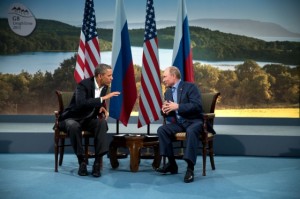By Christina Cameron
On Tuesday, July 29, President Barack Obama announced the United States, along with Europe, would be placing a new set of sanctions on Russia.
These additional sanctions, which come after the original ones placed in March, are geared toward damaging the already stagnant Russian economy.
“The major sanctions we’re announcing today will continue to ratchet up the pressure on Russia including the cronies and companies supporting Russia’s illegal activities in the Ukraine. In other words, today Russia is once again isolating itself from the international community, setting back decades of genuine progress.”
The sanctions, which are also expected to include “cronies” of Russian President Vladimir Putin, are a result of continuous fighting in Ukraine.
The issue between Russia and Ukraine first began in February. The “Crimean Crisis” revolved around the Crimean peninsula, which is (still) recognized by the UN as part of Ukraine. However, earlier this year in March, Crimea was annexed by the Russian Federation.
Crimea is predominantly populated by ethnic Russians, and they are accompanied by ethnic Ukrainians and Crimean Tatars.
The annexation took place after the President at the time, President Viktor Yanukovych fled to Kiev. He was soon after deposed by the Ukrainian parliament, and he was replaced by Oleksandr Turchynov. These events are classified as the Ukrainian Revolution. This new government was and still is formally recognized the United States and the European Union.
These events led Putin to hold a referendum regarding the secession of the Crimean peninsula from the Ukraine. This referendum, found illegitimate by Obama, led him to seek the original sanctions that were placed on Russia.
These sanctions, which were announced on March 17th, followed an executive action that took place earlier in the month. CBS reported that the executive order imposed visa restrictions on pro-Russian opponents of the new government in Ukraine, bringing the total number of individuals facing sanctions to 11. In addition to the visa restrictions, the sanctions froze assets and banned travel for 21 officials in both Russia and Ukraine.
Then just a few days later on March 20th, Obama announced that he would be expanding the list of individuals that were affected by the original sanctions.
At the time, Obama said, “The Russian people need to know and Mr. Putin needs to understand that Ukrainians shouldn’t have to choose between the West and Russia. We want the Ukrainian people to chose their own destiny. That can only happen if Russia also recognizes the rights of the Ukrainian people.”
Talks of new sanctions surfaced in the middle of July. On July 16th, CBS reported that “President Obama announced that the U.S. is levying deeper sanctions on Russia as the West grapples for a way to quell an insurgency in eastern Ukraine widely believed to be backed by Moscow.”
The sanctions were finally announced on Tuesday, and will affect five of Russia’s six financial institutions, along with its oil business.
Rumors that the sanctions are part of new Cold War were shot down by President Obama.
“It didn’t have to come to this. It does not have to be this way,” Obama said. “This is a choice that Russia and President Putin in particular has made. … The path for a peaceful resolution to this crisis involves recognizing the sovereignty, the territorial integrity and the independence of the Ukrainian people.”

